This is a guest post by Mark Wilhelm, an undergraduate student and research assistant in the Dale Lab at the University of Florida Entomology and Nematology Department.
Maybe you’ve seen a huge yellow or black grasshopper lumbering around the yard with a slow, heavy gait. Or, perhaps one of your lush shrubs became a bunch of bare twigs in what seemed like overnight (although it wasn’t). This prehistoric-looking culprit found throughout the southeastern U.S. is the eastern lubber grasshopper (Romanalea microptera), a native species that is flightless and a bad jumper, too.
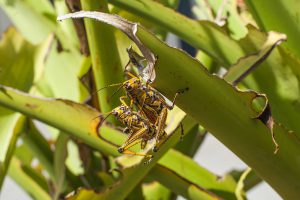
The name “lubber” originates from the Middle English word “lobre,” referring to a clumsy, lazy fellow (as in “land-lubber”). Lubber grasshoppers certainly fulfill their name with their lumbering and buffoonish manner of getting about.
In Florida, the young nymphs, or juveniles, begin showing up in late winter and early spring. These grasshoppers are sociable, especially as nymphs, which can help you find them, but also help them quickly defoliate regions of plants. Nymphs look very similar to adults but are smaller and lack wings. The adult females are about three inches long, while the males are smaller, about two and half inches. Adults have short wings that are used to put on a show for defensive displays and produce sound when rubbed together, but they aren’t used for flight.
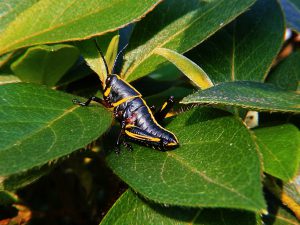

It may surprise many, that rather than multiple species, the several different color phases in this grasshopper are all members of the same species. Lubber grasshoppers can be yellow, black, red, or somewhere in between. Nevertheless, all these color variations are capable of interbreeding. The different color forms can even occur together in the same location.
Pretty colors, but a hidden danger
Slow as they may be, lubber grasshoppers are certainly not helpless. They are brightly colored for a reason – a warning to predators that they are toxic and foul-tasting. When startled, they open their wings, hiss, secrete noxious odors, and even spray toxins in a black liquid that can stain skin or clothes.
Predators, like birds, that are unfortunate enough to eat a lubber grasshopper gag, spit them out, and don’t make the same mistake twice. Animals have even died from the lubber grasshopper’s dangerous secretions. But these toxins do not protect them from everything. The loggerhead shrike, a highly intelligent bird species common to the southern U.S. and Central America, has discovered a way to get around these formidable defenses. It impales lubber grasshoppers on objects like thorns, spines, or barbed wire and leaves them for a couple days to “ripen” in the sun. Once the grasshopper has been left for a while, its toxins degrade to a safe level and the bird can enjoy a meal.
It is important to note that lubber grasshoppers are only dangerous if eaten—picking one up will do no harm. Certainly be careful when handling these grasshoppers because of the liquids they spray, but they are not harmful to humans through contact. Just don’t eat them while you’re out tending to your home landscape or garden.
Is it a pest?
In short – sometimes. One of the more frequently expressed concerns by homeowners about lubber grasshoppers is what plants they may damage. This is a valid concern, because lubber grasshoppers are not picky about what they eat, and they can eat quite a bit. In fact, these insects will devour more than 100 plant species, although they prefer some to others. For instance, they eat broadleaf plants more readily than grasses.
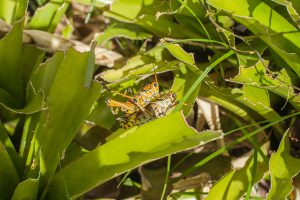
Although they can defoliate entire plants, more typically, they defoliate only regions of plants, eating holes or portions of leaves instead of stripping them bare. Because of this behavior, lubber grasshoppers can be pests of ornamental or vegetable gardens, especially when they gather together. However, they do not do nearly as much damage as one might expect, since they usually move on to other plants quickly after eating one. By eating such a wide variety of plants, lubber grasshoppers are able to ensure their survival in most situations they find themselves in.
So, what to do?
When lubber grasshoppers do need to be controlled, manage small numbers with hand removal or knocking them into a bucket of soapy water. This is particularly easy when they are young nymphs aggregated together on the same branch. Insecticides can be used for larger infestations, but this can be difficult since the grasshoppers are so large and mobile, and it typically not recommended. Lubber grasshoppers are well adapted to eating chemically defended plants, and thus are often able to tolerate insecticides, especially the adults. They can also easily move into a garden from adjacent areas or escape to another area nearby.
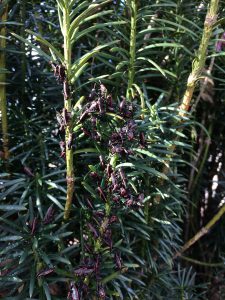
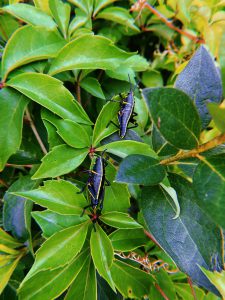
So, next time you find a lubber grasshopper, admire its prehistoric beauty and clumsy capers, and decide if it is something you need to be concerned about. Just one, probably not. A aggregation of nymphs, maybe so. Just don’t eat them.
Curious about this insect or others common around your home landscape?
Check out the ‘Helpful, Harmful, Harmless’ identification booklet for sale at the UF IFAS Extension bookstore.
For more information on the eastern lubber grasshopper visit:
- http://entnemdept.ufl.edu/creatures/orn/lubber.htm
- https://www.fdacs.gov/Divisions-Offices/Plant-Industry/Pests-Diseases/Eastern-Lubber-Grasshopper
- http://bugoftheweek.squarespace.com/blog/2018/11/26/destination-corkscrew-swamp-sanctuary-florida-mighty-defenses-of-the-eastern-lubber-grasshopper-romalea-microptera
 0
0
